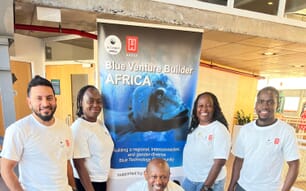Identity
Ctenopharyngodon idellus Valenciennes, 1844 [Cyprinidae]
FAO Names: En - Grass carp (=White amur), Fr - Carpe herbivore (=chinoise), Es - Carpa china
View SIDP Species fact sheet
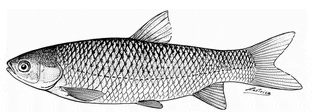
Biological features
Body elongated and cylindrical, round abdomen, compressed at the rear; standard length is 3.6-4.3 times of body height and 3.8-4.4 times of head length; length of caudal peduncle is larger than the width; head medium; terminal mouth and arch-shaped; upper jaw extends slightly over lower jaw, its rear can reach below eye; snout width is 1.8 times of the length, snout length is about the nasal distance; no palpus; gill rakes short and sparse (15-19); two rows of pharyngeal teeth on each side, laterally compressed, formula 2.5-4.2, inner row stronger, grooves on the lateral surface; scales large and cycloid; extreme 39-46 scales in lateral line, lateral line extends to caudal peduncle. Anus close to anal fin; Dorsal fin ray: 3,7; pectoral fin ray: 1,16; ventral fin ray: 1,8; anal fin ray: 3,8; caudal fin with around 24 rays; body color: greenish yellow laterally, dorsal portion dark brown; greyish white in abdomen.
Profile
Historical background
Grass carp culture began in the areas along the Yangtze and Pearl Rivers in the southern part of China. Compared to common carp, the culture of grass carp started much later. According to historical records, the culture of grass carp was closely related to the will of the current governor.
In the Tang Dynasty (618-904 A.D.), the family name of the emperor happened to be pronounced the same in Chinese as common carp, the only fish cultured then. The royal family prohibited common carp to be sold and killed by the people. Therefore, grass carp was chosen by the farmers as a substitute for aquaculture together with silver carp, bighead and black carp; this was because the seed of these fish were easily available in the areas along the Yangtze River and the Pearl River.
The culture of grass carp remained relatively small in scale due to the dependence on the natural supply of seed. Success in induced breeding technology significantly promoted its culture. The fish has been introduced to more than 40 other countries; sometimes it is referred to as the white amur.
About 10 000 tonnes/yr in 1950, the global production of farmed grass carp had reached over 100 000 tonnes/yr by 1972, exceeded 1 million tonnes/yr by 1990, and has been above 3 million tonnes/yr since 1999. China is by far the major producer (3 419 593 tonnes in 2002, 95.7 per cent of the global total).
Main producer countries
In 2006, many countries reported cultured production of grass carp to FAO but only some of them (Bangladesh, China, Taiwan, Islamic Republic of Iran, the Lao People's Democratic Republic, Myanmar and Russian Federation) reported a production greater than 1,000 tonnes.
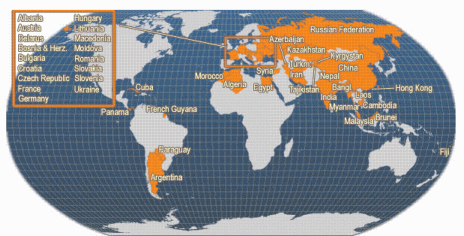
Habitat and biology
Grass carp is a native Chinese freshwater fish with a broad distribution from the catchment area of the Pearl River in southern China to that of the Heilongjiang River in northern China. It has been introduced to about 40 other countries and there have been limited reports about the natural populations occurring in those areas; for instance, a natural population exists in the Red River in Vietnam.
It inhabits lakes, rivers and reservoirs. It is a basically herbivorous fish that naturally feeds on certain aquatic weeds. However, the fry/larvae feed on zooplankton. Under culture conditions, grass carp can well accept artificial feed such as the by-products from grain processing, vegetable oil extraction meals, and pelleted feeds, in addition to aquatic weeds and terrestrial grasses. Grass carp normally dwell in mid-lower layer of the water column. Comparatively, it prefers clear water and can move swiftly.
It is a semi-migratory fish; the mature broodstock migrate to the upper reaches of major rivers to propagate. Flowing water and changes in water level are essential environmental stimuli for natural spawning. The fish can reach sexual maturity under culture conditions, but cannot spawn naturally. Hormone injection and environmental stimuli, such as flowing water are necessary for induced spawning in tanks. Gras carp grow rapidly and reach a maximum weight of 35 kg in the wild.
Production
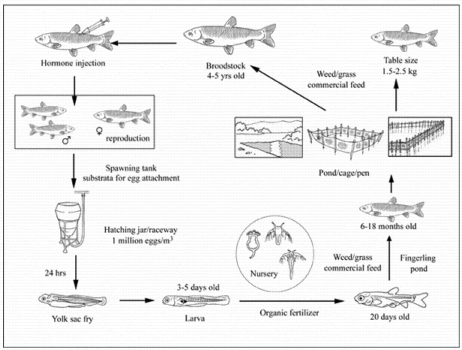
Production systems
Various production systems are currently used for the culture of grass carp the major ones include semi-intensive and intensive culture ponds, and pens and cages in open waters.
Seed supply
At present artificial propagation is the major supply of seed for the culture of grass carp, although natural seeds are still available in some rivers of China. Seed collected from the wild is mainly used for maintaining the genetic quality of the broodstock. Broodstocks used for artificial propagation are usually raised in captivity from seeds from the wild or from breeding stations where good natural stocks are maintained.
Hatchery production
Well-matured breeders are released into the spawning tank (round cement tank with diameter of 6-10 m and water depth of around 2 m) after being injected with inducing hormone (usually LRH-A). Water circulation is maintained throughout the spawning period.
Eggs are transferred to hatching raceways or jars, either manually or by gravity. Hatching raceways (which are round or ellipse-shaped structures) are commonly used for large-scale production. The width of the raceways is normally 0.8 m and the depth is 0.8-1.0 m. The inlets are mounted on the bottom of the raceways with openings in the same direction and at an angle of around 15° to the bottom, to promote water circulation. Screens are mounted on the inner wall for discharging water during the operation. Water can be totally drained out through the outlet on the bottom. Current flow is maintained during the hatching period to keep the eggs and larvae suspended in the water column.
In India, dry or wet stripping methods are used for the seed production of grass carp. Pituitary extract or synthetic agents such as ovaprim are used for induction (John Stephen Kumar, pers. comm. 2004).
Nursery
Earthen ponds (usually 0.1-0.2 ha and 1.5-2.0 m deep) are used for the nursing of grass carp. Ponds are chemically cleared, normally with quicklime, to eliminate all harmful organisms after totally drying. The usual dose is 900-1 125 kg/ha.
Organic fertiliser, animal manure and/or plant wastes (‘green manure‘) is commonly applied to increase the natural biomass of algae and zooplankton 5-10 days before the stocking, according to the water temperature. The quantity of organic fertiliser used is usually 3 000 kg/ha for animal manure or 4500 kg/ha for green manure. Green and animal manures can be used simultaneously but the quantity of each should be reduced accordingly.
Monoculture is practiced in the nursery stage, with a stocking density normally ranging between 1.2-1.5 million/ha, depending on the length of rearing and targeted size. The nursery operation usually takes 2-3 weeks in China.
Organic fertilisation is carried out at frequencies and rates sufficient to maintain high pond fertility and therefore a good supply of natural food organisms (especially zooplankton) for the fish. The quantity ranges from 1 500-3 000 kg/ha once every 4-5 days for animal manure or green manure, depending on existing water fertility.
Soybean milk can also be used as both direct feed and fertiliser to replace organic fertiliser in the nursery stage. The normal quantity is 3-5 kg (dry soybean)/100 000 fish daily. This usually means production costs are high. A paste-form of soybean cake or other by-products from grain processing is applied from the 5th day after stocking, usually at a rate of 1.5-2.5 kg/100 000 fish daily.
A paste of water peanut, water lettuce and water hyacinth can also be used to replace the above-mentioned feed and fertilisers at the rate of 25-40 kg/100 000 fish daily. 0.5 per cent of table salt needs to be added to the paste of water peanut to remove its saponin toxicity. Normal survival rates in nursery ponds are 70-80 per cent, although it may reach over 90 per cent under good management.
The fish usually reach the size of about 30 mm in length after 2-3 weeks of rearing. These are called summer-fingerlings in China and are ready for the fingerling rearing stage. Conditioning, through careful netting and holding the fish at high density for a while (several hours) is required before the transfer of summer-fingerlings to the fingerling pond. This practice is designed to fish tolerance to stress before they are transported.
Rearing fingerlings
Summer-fingerlings are not suitable for direct stocking in grow-out ponds; they need to be reared to the fingerling stage (13-15 cm in length or larger) first. The technique for fingerling rearing is rather different to the nursery operation, especially when grass carp are stocked as the major species. The major differences include the following:
- Relatively larger (0.2-0.3 ha) and deeper earthen ponds are used for fingerling rearing.
- Contrary to the nursery stage, polyculture is usually adopted for the production of grass carp fingerlings (monoculture at this stage is quite rare). Grass carp can be polycultured with other carp species except black carp (Mylopharyngodon piceus).
- The stocking density is 120 000-150 000/ha when it is the major species in the pond or 30 000/ha when it is the secondary species.
- Feeding is vitally important throughout the fingerling rearing period. Grass carp are mainly fed with Wolffia arrhiza when it is between 30-70 mm in length. The initial feeding rate is 10-15 kg/10 000 fish daily and is gradually increased according to the demand of the fish. The feed is changed to duckweed (Lemna minor) when the fish is between 70-100 mm in length. After that, the fish can be fed with tender aquatic weeds and terrestrial grasses. In addition, commercial feeds (soybean cake, rapeseed cake, wheat bran, rice bran, etc.) are also fed at a daily rate of 1.5-2.5 kg/10,000 fish.
- Fingerling rearing normally takes 4-6 months for above mentioned size and stocking density in China. The period can be considerably shortened in warmer climates or if lower stocking densities are used.
- The normal survival rate through the whole fingerling rearing period should be above 95 per cent.
It is difficult to culture grass carp from the yearling size (13-15 cm) to marketable size (>1 500 g) within one year in most parts of China; it is therefore common practice to rear yearlings to 2 year old fingerlings for grow-out stocking. The stocking density is much reduced, compared to the rearing of yearlings. The feeding regime is similar but the rate is much higher. By the end of this period, the fish have usually reached about 250 g. This practice is not necessary in tropical and subtropical areas, where yearlings of grass carp can reach marketable size within one year, due to high temperatures.
In Vietnam, the rearing of grass carp before the grow-out stage is divided into two periods. Fry are first raised to 4-5 cm, with a stocking density in the earthen nursery pond of 200-250 fry/m². The rearing period is normally 1.5-2 months. Then the fish are further raised for about 2 months to a size of 12-15 cm at a much lower density. The fish is mainly fed with soybean powder, rice bran, maize powder and aquatic plants (Azolla sp.) after reaching 3 cm in body length.
The nursery rearing of grass carp in India is carried out in intensively fertilised ponds, adequately enriched with zooplankton and unicellular algae. Generally the survival of fry is about 70-80 per cent in well-managed nursery ponds. In addition to the natural feeds developed, supplementary feeding with powdered groundnut oilcake and rice polishings or bran is also practiced (John Stephen Kumar, pers. comm. 2004).
Ongrowing techniques
The most commonly adopted ongrowing techniques for grass carp include polyculture in ponds and pen and cage culture in lakes and reservoirs.
Semi-intensive to intensive polyculture in ponds in China
For polyculture in ponds or pens, grass carp can be stocked either as the major species or a secondary species together with other carp species. The total stocking density is 750-3 000 fish/ha with a stocking size of 125-250 g. Aquatic weeds and terrestrial grasses form the major feed for grass carp in grow-out culture. Feeding commercial feeds such as pellets and by-products from vegetable oil extraction and grain processing are becoming more popular as a means of replacing aquatic weeds and grasses to save labour costs in pond culture. The yield of grass carp is usually 1 000-3 000 kg/ha, which accounts for 15-40 per cent of the total production.
Intensive culture in cages in China
In intensive culture systems in cages, grass carp are usually stocked as major species. Cages are usually about 60 m², with a depth of 2-2.5 m. 250-500 g fish are stocked at 10-20/m³, depending on the targeted production. In addition, 30-50/m³ Wuchang fish (bluntnose black bream, Megalobrama amblycephala), are also stocked at a size of 80-125 g. Silver and bighead carp are also stocked at 1 per cent of the total, as 'cage cleaners'.
The fish are fed with aquatic weeds/terrestrial grasses and pelleted or other commercial feeds. The culture period is usually 8-10 months and the yield is normally 30-50 kg/m³. Grass carp usually account for 60-70 per cent of the total production. Cage culture of grass carp through the use of commercial feeds involves relatively high production costs.
Feeding efficiency is not always as high in cage culture as in pond culture so, where terrestrial grass and aquatic weeds are locally abundant, collecting them and applying them in cage culture usually requires less labour input as the transportation is limited.
Grow-out systems in other countries
The grow-out of grass carp is mainly conducted in earthen ponds and cages in Vietnam. Polyculture with other species (eg silver carp, common carp, rohu and mrigal etc) is common. Grass carp may be stocked as either major or secondary species. Grass carp usually account for 60 per cent of the total stocking density of 1.5-3 fish/m² (dependent on the level of intensity) in ponds and the fingerling size is 5-6 cm (mountainous areas) and 12-15 cm (lowlands).
The stocking rate in cage culture is 20-30 fish/m³ but much larger fingerlings are used (normally 50-100 g). Grass carp are usually fed with terrestrial grasses, cassava leaves, banana stems and maize leaves in grow-out culture. Grass carp production usually accounts for 60 per cent of total production (7-10 tonnes/ha) in ponds. The marketing size for grass carp is 1-1.5 kg and 1.5-2.5 kg in ponds and cages respectively.
In India, grass carp are cultured as an important species in pond-based composite systems consisting mainly of Indian major carps and Chinese carps. The grass carp stocking density depends mainly on the availability of aquatic weeds and terrestrial grasses but is usually 5-20 per cent of the total. Aquatic weeds (Hydrilla, Vallisneria, Wolffia) and terrestrial grasses such as Napier grass and other hybrid grasses are the major feeds in grass carp farming. Normally, grass carp reach 0.5-1.5 kg in 8-10 months (John Stephen Kumar, pers. comm. 2004). The total production from such systems can reach 8-10 tonnes/ha/yr.
Feed supply
Grass carp can be reared with commercial feeds or natural food, such as aquatic weeds and grasses. They prefer relatively low fertility. Production is mainly limited by water quality. The commercial feeds used for grass carp are relatively low in protein (28-30 per cent) and their raw materials include soybean cake/dregs, rapeseed cake and wheat bran etc. Aquatic weeds can be collected from natural water bodies. Terrestrial grasses can be grown on the pond dyke with organic manure.
Harvesting techniques
Both selective and total harvesting are practiced for grass carp. Selective harvesting is usually conducted in the early morning (because temperatures are relatively low and for morning sales) during late summer and autumn. Individuals of marketable size are selected after netting (a single netting for each harvest). Total harvesting is carried out at the end of the culture period. Several nettings are usually carried out before total drain-down of the pond. All the fish are harvested at the end of the year, either for marketing or for restocking (individuals below marketable size) for the next production cycle.
Handling and processing
Grass carp is normally sold live or fresh. A small quantity of the production is processed by ready-to-eat food stores; in this case the most commonly used processing method is deep frying.
Production costs
The production cost of grass carp vary according to the culture practice used but are normally about USD 0.50/kg of fish produced. Feed costs comprise the largest portion of production costs.
Diseases and control measures
Farmed grass carp are rather susceptible to various diseases. Major diseases and methods of control are listed in the table below.
| DISEASE | AGENT | TYPE | SYNDROME | MEASURES |
|---|---|---|---|---|
| Haemorrhagic Disease | Reovirus (GCRV) | Virus | Red muscle caused by haemorrhage; red fin; red operculum and enteritis; high mortality (30-50 per cent of infected fish) | Vaccination through injection; disinfection of fish seed and culture environment with chlorine-compounds, quicklime and potassium permanganate; Chinese Rhubarb (Rheum officinale); sweet gum leaves (Liquidambar taiwaniana); cork tree bark (Phellodendron) and skullcap root (Scutellaria baicalensis) |
| Bacterial Septicemia | Aeromonas sobria; Aeromonas hydrophila; Yersinia ruckerri; Vibrio sp. | Bacteria | Hyperaemia at different positions of body, such as jaws, mouth cavity, operculum, fin-base and whole body when serious; protruded eyeball; swollen anus; expanded belly; erected scales; gill rotten and reduced feeding etc; high mortality of fish | Disinfect the fish and culture environment with quicklime and potassium permanganate; "Yu Tai III" (commercial drug of multi herb ingredients) through medicated feed |
| Bacterial Enteritis | Aeromonas punctata f. intestinalis | Bacterium | Red spot on the belly; enteritis; red and swollen anus; expanded belly and losing appetite | Disinfection of culture environment with bleaching powder and quicklime; sulphaguanidine and furazolidone; Chinese herbs (garlic, Euphorbia humifusa, Aclypha australis, Polygonum hydropiper and Andrographis paniculata) |
| Bacterial gill-rot disease | Myxococcus piscicola | Bacterium | Rotting of gill filament; congestion of inner membrane of operculum; small round transparent portion on the operculum and gill filament attached with mud | Bathing fish in 2-2.5 per cent saline water; pond disinfection with quicklime and chlorine compounds; Chinese herbs such as Galla chinensis, Sapium sebiferum and Chinese rhubarb; furazolidone |
| Erythroderma (red-skin disease) | Pseudomonas fluorescens | Bacterium | External haemorrhage and inflammation; losing scales; congested fins and rotten fin rays | Careful handling during transportation and stocking; disinfection of pond with bleaching powder; sulphathiazole; Chinese gall (Galla chinensis) |
| Bothriocephalosis | Bothriocephalus sp. | Tapeworm | Physically weak; reduced feeding; opening mouth; very high mortality | Disinfection of pond with quicklime and dipterex; pumpkin seed through medicated feed |
| Dactylogyriasis | Dactylogyrus sp. | Helminth | Weak physically; dark body colour; slow moving; reduced feeding and difficult in breathing | Spraying of quicklime and dipterex in pond; dipping the fish with dipterex or potassium permanganate solution |
| Ichthyophthiriasis | Ichthyophthirius multifiliis | Protozoan extoparasite | Attached to skin and gill filaments; form whitish sac on body surface; high mortality | Thorough disinfection of pond with quicklime; mercury nitrate (banned); Malachite blue (poorly effective) |
| Sinergasiliasis | Sinergasilus (female) | Copepod | Difficulty in breathing; damaged gill; inflammation and rotting of gill filament; madly circle on the water surface and die of exhaustion | Pond disinfection with quicklime; spraying of dipterex or ferrous sulphate or copper sulphate |
Suppliers of Pathology Expertise
Assistance can be provided from the following sources:
- Research Institute of Hydrobiology, CAS, Wuhan City, Hubei Province, China.
- Shanghai Fisheries University, Shanghai, China.
- Pearl River Fisheries Research Institute, CAFS, Guangzhou City, China.
- Freshwater Fisheries Research Centre, CAFS, Wuxi, Jiangsu Province, China.
- Zhejiang Provincial Freshwater Fisheries Research Institute, Huzhou City, Zhejiang Province, China.
- The Central Institute of Freshwater Aquaculture (ICAR), Kausalyaganga, Bhubaneswar, 751002, Orissa, India.
Statistics
Production statistics
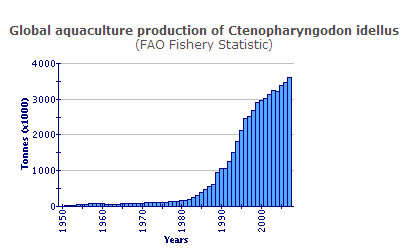
Global production of cultured grass carp was only 10 527 tonnes in 1950. By 2002 it had reached 3 572 825 tonnes, an increase of more than 339 times in 52 years, and accounted for 15.6 per cent of global freshwater aquaculture production. During the decade 1993-2002, the average annual growth rate of cultured grass carp production was 10.1 per cent globally and 9.9 per cent in China. Expansion in the rest of the world during this decade was, from a relatively tiny baseline, much faster (17.8 per cent/yr).
However, some slow-down seems to be occurring, since farmed grass carp production only grew by 3.3 per cent between 2001 and 2002, both in China and globally. Production fluctuated quite wildly in many countries in the decade 1993-2002. Production in India, which was about 13 000 tonnes in 1993, reached a peak of over 137 000 tonnes in 1999 but had fallen to less than 48 000 tonnes by 2002. However, production in one of the other major producers, Egypt, increased steadily throughout the decade.
The global value of global grass carp aquaculture production was US$ 2.92 billion in 2002, an annual expansion rate between 1993 and 2002 of 7.5 per cent/yr. The slower growth rate in terms of value, as compared to volume, was mainly due to changes in the valuation of the Chinese RMB yuan against the US dollar.
Market and trade
The major producer of this species is China where, traditionally, grass carp are consumed fresh. Most of the production is marketed fresh, either as whole fish or as pieces. Very little production is processed. At the present time, grass carp is mainly a locally consumed product but some of those produced in Guangdong province (southern China) are marketed in Hong Kong.
There is no specific data on the quantity of exported grass carp in Chinese statistical information. However, 41 798 tonnes and 4932 tonnes of live fish (species not specified) were exported to Hong Kong and Macao from the mainland of China in 2002, according to the national statistic yearbook of imports and exports of aquatic products. Grass carp must have comprised large proportion of this total.
Grass carp is a low price commodity that is affordable to middle and low income classes in China and other countries. There has been a slight decline in the price of grass carp in the past few years in China. Currently, retail prices are usually USD 0.7-1.0/kg. There are no specific regulations relating to the marketing of the grass carp because the fish is basically for local consumption.
Status and trends
Grass carp has a long history in aquaculture and is one of the most important species cultured in inland water bodies in China. There have been great efforts devoted to research on this species; the most important achievement has been success in the development of induced breeding technology. This ensures a constant supply of seed for large-scale farming.
Another important aspect of research was the study of nutritional requirements and the development of cheap pelleted feed. As this species is easily susceptible to disease, there have also been a lot of studies on disease control under culture conditions. The best-studied disease of grass carp is haemorrhagic disease, which has a viral agent. Effective preventive measures, especially a vaccine have been successfully developed and applied. Culture techniques and models for pond, cage and pen culture have also been well developed.
After silver carp, grass carp currently has the largest production in freshwater aquaculture globally. However, the rate of expansion in China (by far the major producer) has been declining in the last several years. Due to the introduction of new species and changes in people's preferences, grass carp is getting less popular now.
Chinese people still prefer to eat whole fish, but whole grass carp are a little too large for the small Chinese families (3 persons mostly) to consume in one meal. It seems that grass carp culture has more potential for development in other countries, especially developing countries. Its fast growth rate, large size, lack of fine inter-muscular bones and, most importantly, feeding habits make the fish an ideal species for culture in these areas. Rapid expansion of its culture outside China may imply that this great potential is being realised. However, appropriate processing technology is required for the fish to enter international markets.
Grass carp not only grow quickly but have a low requirement for dietary protein. They can be produced at low cost by feeding them with aquatic weeds, terrestrial grasses and by-products from grain processing and vegetable oil extraction. Seed can be produced through induced breeding at a large scale and very low cost. The culture of grass carp can be well integrated into crop farming and animal husbandry, to maximise the utilisation of natural resources.
On the other hand, it is a large fish without fine inter-muscular bones. It is acceptable to consumers in many countries and it very likely has good potential for development. The market for grass carp is close to saturation in the eastern part of China, where aquaculture is well developed now. However, there is still a considerable potential market in central and western China and many other developing countries.
Main issues
Pond based polyculture of grass carp does not have much negative impact on environment. The integration of grass carp - grass cultivation - pig rearing is an ecologically sound production model. However, large-scale intensive culture of grass carp with commercial feeds in cage/pen in shallow open-water may pollute the environment by discharging various wastes, which might accelerate the process of eutrophication. Besides, grass carp is more easily susceptible to some diseases. Poor management in fish health might results in extensive use of different chemicals and drugs, which may affect the quality of the fish and pollute the water at the same time. For the convenience and reducing labour input, farmers are using more and more pellet feed in grass carp culture in pond and cage/pen in open water. Wasted feed and discharge of nutrients may cause adverse impact on the environment.
Responsible aquaculture practices
Several issues need to be addressed in considering responsible aquaculture practices for grass carp culture:
- The first is the use of antibiotics and other drugs in disease control in the intensive culture of grass carp, which are more easily susceptible to various kinds of diseases than other carp species. Due to high stocking densities and poor water quality resulting from various wastes such as unutilised feed and fish faeces, grass carp are often infected with bacterial, viral and parasitic diseases. Antibiotics and other chemicals are sometimes used for treatment. This form of abuse may cause negative impacts, either directly or indirectly, on consumers. Efforts should be made to ensure that reasonable stocking densities, good feeding practices and quality feeds (for other fish in the pond), and good water management are used to minimise the occurrence of these various disease problems. The relevant government regulations must be strictly observed whenever chemicals and drugs are used.
- The second is the impact on the natural environment of intensive grass carp culture. Presently, the feed used is usually cheap and the FCR is high (usually >2:1). Thus a rather small proportion of the feed is utilised by the fish. The unutilised portion and the wastes discharged by the fish can cause significant environmental impacts and may accelerate eutrophication. Careful planning of cage and pen culture developments inland water bodies, especially shallow lakes, is very important. The utilisation of natural feeds such as aquatic weeds and terrestrial grasses can reduce these adverse impacts. The use of highly digestible feeds and better feeding practices can also assist. Similar problem exist when grass carp are intensively farmed in ponds. With the increasing use of artificial feeds, unutilised feed and other wastes accumulate in the ponds, whose contents are normally totally discharged into natural water bodies at the end of culture operations. Reasonable stocking densities, integrated fish farming, and careful feeding management are highly recommended in order to minimise environmental impact.
- A third issue is the genetic quality of the seed used in farming. Artificial breeding of this species has been practiced for four decades in China. Breeding control was not always regarded as having high importance by every hatchery operator in the past. Inbreeding actually happened in quite a few farms in the past. This caused a degradation of the quality of seed produced for culture. This may result in poor growth performance and less disease resistance. The latter problem can also bring another dilemma - increased use of antibiotics and other drugs. Therefore, induced breeding of grass carp should be carried out with carefully maintained broodstock of genetic quality.
January 2010




